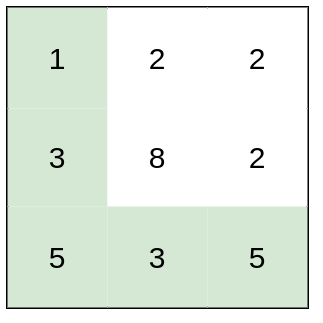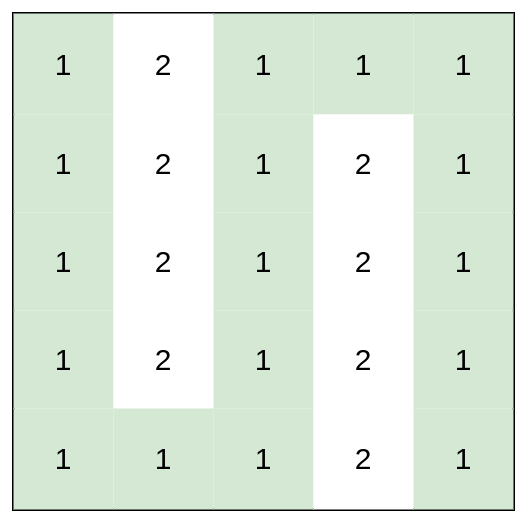1631. Path With Minimum Effort
You are a hiker preparing for an upcoming hike. You are given heights, a 2D array of size rows x columns, where heights[row][col] represents the height of cell (row, col). You are situated in the top-left cell, (0, 0), and you hope to travel to the bottom-right cell, (rows-1, columns-1) (i.e., 0-indexed). You can move up, down, left, or right, and you wish to find a route that requires the minimum effort.
A route's effort is the maximum absolute difference in heights between two consecutive cells of the route.
Return the minimum effort required to travel from the top-left cell to the bottom-right cell.
Example 1:

Input: heights = [[1,2,2],[3,8,2],[5,3,5]]
Output: 2
Explanation: The route of [1,3,5,3,5] has a maximum absolute difference of 2 in consecutive cells.
This is better than the route of [1,2,2,2,5], where the maximum absolute difference is 3.
Example 2:

Input: heights = [[1,2,3],[3,8,4],[5,3,5]]
Output: 1
Explanation: The route of [1,2,3,4,5] has a maximum absolute difference of 1 in consecutive cells, which is better than route [1,3,5,3,5].
Example 3:

Input: heights = [[1,2,1,1,1],[1,2,1,2,1],[1,2,1,2,1],[1,2,1,2,1],[1,1,1,2,1]]
Output: 0
Explanation: This route does not require any effort.
Constraints:
rows == heights.lengthcolumns == heights[i].length1 <= rows, columns <= 1001 <= heights[i][j] <= 106Key Concepts and Constraints
What Makes This Problem Unique?
Graph Representation:
This problem can be mapped to a graph where each cell in the 2D matrix is a node. The edges connecting these nodes represent the "effort" required to move from one cell to another.Variants of Shortest Path Algorithms:
The objective is similar to finding the shortest path, but with a different metric. We need to minimize the maximum absolute difference between adjacent nodes.Constraints:
Strategies to Tackle the Problem
- Dijkstra's Algorithm:
A classic algorithm for finding the shortest path in a weighted graph, adapted for this problem. Dijkstra's Algorithm Explained
What is Dijkstra's Algorithm?
Mechanics of Dijkstra's Algorithm in "Path With Minimum Effort"
Initialize Priority Queue:
- The algorithm starts at the top-left corner (the source). The priority queue is initialized to store the effort needed to reach each cell from the source. The effort for the source itself is zero.
Distance Matrix:
- A 2D array keeps track of the minimum effort required to reach each cell. Initially, this is set to infinity for all cells except the source.
Iterate and Update Distances:
- The algorithm pops the cell with the smallest effort from the priority queue and explores its neighbors. The effort required to reach a neighbor is updated if a smaller effort is found.
Early Exit:
- The algorithm stops when it reaches the bottom-right corner, returning the effort required to get there.
Time and Space Complexity
- Time Complexity: , where and are the dimensions of the grid. This is primarily due to the operations on the priority queue.
- Space Complexity: , needed for the distance matrix and the priority queue.
Comments
Post a Comment